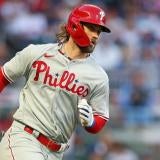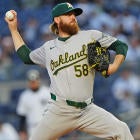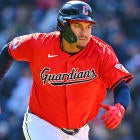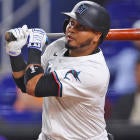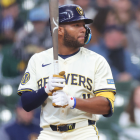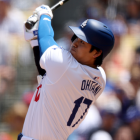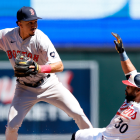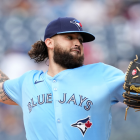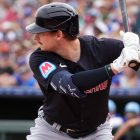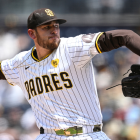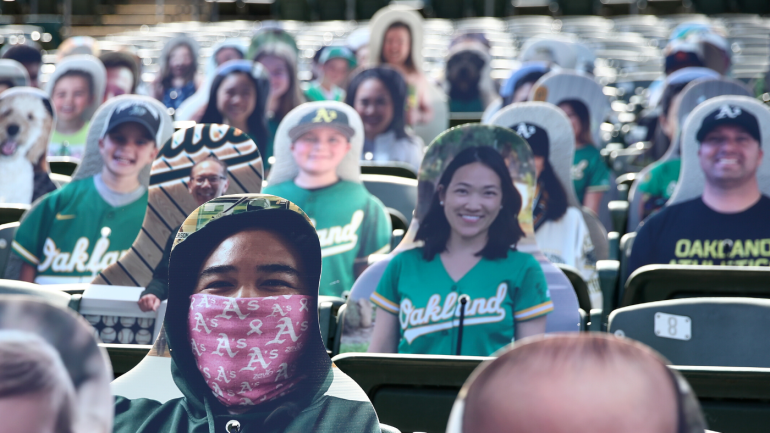
After a nearly four-month delay to the start of the 2020 season due to the coronavirus pandemic, Major League Baseball is set to make its return this week. Two regular-season games are on the calendar for July 23 (Washington Nationals vs. New York Yankees and San Francisco Giants vs. Los Angeles Dodgers) and the rest of the league will begin play on July 24.
The 60-game regular-season sprint is set to finish on Sunday, Sept. 27. Teams will play "regional" schedules in 2020. They'll face the other four teams in their division 10 times each and play 20 games against the interleague teams in their region (for example, teams in the National League East will face American League East teams).
Tense, drawn-out negotiations between MLB owners and the MLB Players Association and the owners' desire for a shorter season eliminated the chance for baseball to return earlier. Now, baseball will compete for viewership against the NBA (season restart set for July 30), along with the NHL (the Stanley Cup Playoffs start Aug. 1). Other professional American sports like golf, NASCAR, NWSL and MLS made their returns in recent weeks.
MLB, like most sports, will begin the season without spectators in attendance, and potentially all of the 2020 MLB season could be played behind closed doors. Some owners and local governments are hoping to include fans at the ballpark at some point this season, but it's unclear if and when that could happen.
Keeping players, managers, umpires, coaches, team staff and their families healthy is paramount during the short season, especially with coronavirus cases surging in some parts of the United States. MLB has already experienced issues with its coronavirus testing process, and uncertainty will hover over the 2020 season as it gets started.
With that being said, we're going to discuss some ways MLB can improve the fan experience in 2020. It's possible that some of these suggestions will be tough to implement due to COVID-19-related restrictions or television or stadium production limitations, but we think they're worth throwing out there. Granted, MLB could help itself gain fans by lifting MLB.tv blackout restrictions for this 60-game season since streaming is one of the only ways to consume baseball this year, but, alas, here are some other ways baseball can try to enhance MLB fans' viewing experience.
1. Artificial crowd noise
I already know that this one is controversial. But honestly, in the big picture, fake crowd noise really isn't that bad. Sure, it's a little unnatural so it might be off putting at first, but I think adding crowd noise into an empty stadium helps fans (and possibly the players as well) feel a tiny twinge of normalcy. Basically, why not give it a shot?
In 2015, the Baltimore Orioles and the Chicago White Sox played a fan-less game at Camden Yards, and I remember watching it on MASN with Gary Thorne on play-by-play.
They kept some of the typical game traditions, like playing the players' walk-up songs and music/sound in between and in the middle of the innings, but there were no other additional sounds. You could also audibly hear the Orioles PA announcer announce each batter, something that wouldn't normally be picked up in a broadcast with fans in the stadium.
"You realize how much the crowd really matters to the broadcast and obviously to the players too," Thorne told YES Network last March. The Orioles-White Sox game remains the only crowd-less game in MLB history, but that will change next week. And it appears artificial crowd noise will be part of the 2020 season.
MLB has already committed to adding in artificial noise in stadiums to offset the absence of spectators. It's something that's been tested out at a few ballparks during spring training 2.0. Take a listen:
Just like the old days. 💣
— SportsNet LA (@SportsNetLA) July 2, 2020
(🎥: @redturn2) pic.twitter.com/cTXiGNMxyi
You can hear the piped in ambient crowd noise as a low buzz, then get louder as play is made. #Rays getting first listen today pic.twitter.com/F3G6A4c1Aj
— Marc Topkin (@TBTimes_Rays) July 16, 2020
Tip of the cap to tonight's "crowd"... They really brought the energy. pic.twitter.com/7cIyvWi0Rs
— Cincinnati Reds (@Reds) July 15, 2020
"The silence is really awkward," a baseball executive told The Athletic recently. "It's [artificial crowd noise] to simulate a more normal experience."
Dom Smith of the Mets recently said that the fake crowd noise didn't sound authentic, so maybe MLB finds sound from prior broadcasts or plays around with mixing MLB The Show crowd noise with real fan noise. Either way, I'm sure by the time the season is in full swing, the operators of the fake crowd noise will have worked out the kinks and managed to time it as close as they can to a real reaction. It'll be weird at first, but isn't nearly everything weird right now?
2. Mic'd up players
This is something we already know is a whole lot of fun. Again, if COVID-19 restrictions allow and MLB players agree, mic'ing up players for a few innings in a handful of games every week in this 60-game season would be great. Aside from the all-access/behind the scenes feel, having players wear microphones on the field and in the dugout is also a really fantastic way for fans to get to know players a little bit more. Baseball is always being talked about as a sport that doesn't market its superstars enough, and adding a mic to some of the game's best players is one way to ease that narrative.
Take this past spring training for example. Chicago Cubs teammates Anthony Rizzo and Kris Bryant were mic'd up during a game, and it brought fun and frivolity to the broadcast. Braves first baseman Freddie Freeman was hilarious during his mic up session this spring, as well.
Mets star Pete Alonso even went so far to say that he enjoyed his mic'd up experience in spring training so much that he would be willing to allow the league to place a microphone near first base during select games during the 2020 season to pick up conversations players have at the bag. In fact, Alonso has already committed to mic-ing himself up throughout the 2020 season. The best highlights from Alonso's mic will be posted in episodes on the Mets star's YouTube channel. Alonso said that growing the game of baseball is important, and credited using technology and social media as ways to expand the game's reach.
If anything, fans all across the world could use some lightheartedness right now. Also, let's not just restrict mic'd up players to the national broadcasts. Why not use it in both national and regional games, if you could make it work?
Along with the mic'd up players for more access, I'd also be down for adding some new camera angles to broadcasts. The 'catcher cam,' for one, has been really enjoyable. Anything that's unique and offers a new perspective, it's worth a try this season. You could even just make the exclusive camera shots an option for fans on social media or within the MLB At-Bat app. These are (seemingly) easy ways to provide extra entertainment this season.
3. Cardboard cutouts
The best strategies for this season are going to be the most creative and innovative. It also helps if you don't take things too seriously. The Oakland Athletics and San Francisco Giants are among a handful of MLB clubs that have said that they will offer the option for fans to buy cardboard cutouts of themselves to fill empty stadiums. The Dodgers are even offering cardboard cutouts for fans' dogs. and they'll create a special section just for its four-legged fans. Baseball fans can send out a photo of themselves (or pets) sporting their team gear, then that photo then gets printed onto a cardboard cutout, and then that cutout gets placed somewhere in the stands of their home team's ballpark. It's harmless fun, albeit a little creepy. Bonus points for the clubs who donate a portion (or all) of the profits from the cardboard cutout sales to COVID-19 relief programs. (The A's, for their part, will also send any foul balls that strike the cutouts to the fans in question.)
If clubs aren't jumping on the cardboard cutout train, then maybe they can try incorporating some technology to connect with fans. Allow fans to submit a video entry to be displayed on the stadium video board, maybe they're cheering or giving a shoutout to their favorite player. For Dodgers fans, maybe it's a personalized booing video for when the Astros come to town. Nothing is going to fully make a fan feel like they're at the ballpark this season, but I give props to any team trying.
4. A thanks to club staff
Highlighting some of the MLB staff responsible for helping organize the season, whether it's just a shout-out on the broadcast, or some sort of on-field (or at-home) ceremony. There's lots of people that helped make this season a possibility, all while adjusting to a completely new way of working in baseball. It could be anyone from a stadium security guard, who had to unexpectedly factor in COVID-19 into their work, or someone from a club's social media team. These people aren't essential workers, and they didn't sign up to be dealing with public health and safety when they got a job in baseball. So, I'm sure fans could appreciate a quick kudos to them for their part in helping make a season possible
5. More day games? (it might be too late)
OK, so this one can't probably can't be applied since the 2020 schedule is already out. But in an abbreviated season, where the majority of the games are going to be happening in the middle of summer, why couldn't MLB schedule more day games? A vast majority of games in 2020 will be played under the lights, including on Opening Day when the earliest first pitch is 4:10 p.m. ET. The majority of young baseball fans are going to be home this summer -- because of the coronavirus pandemic, most children's camps are cancelled, some gyms and recreational centers are still closed and summer schools are being conducted virtually. What better way to grab the attention of the younger generations than having a handful of games in the middle of the day? I understand the difficulties in scheduling day games this summer, given the new geographically based schedule, but given where it would be acceptable, it would have made sense to throw a few more 1, 2 and 3 p.m. starts on the slate.











